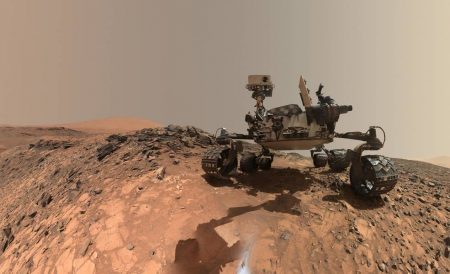June 7, 2018 – The Curiosity rover has been searching for organic compounds as it ascends the flanks of Mount Sharp in the Gale Crater. And today at a NASA-held press conference, scientists announced two new pieces of evidence related to this subject:
- they found preserved in rocks organic molecules that suggest Mars may have supported life in its past.
- that the Martian atmosphere contains organic molecules that may suggest a living or chemical origin.
The source of these organic molecules remains unknown.
Does that mean there has been life or is life on Mars? No one in the NASA community would suggest we leap to that conclusion.
So let’s review what we know about the site Curiosity is exploring which may give us clues as to the likelihood of ancient or present life.
The surface conditions at today’s Gale Crater are brutally inhospitable to life as we know it. Radiation from space and the chemistry of surface regolith makes it impossible to believe anything could be alive.
But water once ran across the surface of Gale Crater a very long time ago. And where water is found most scientists believe the chances for life to emerge are pretty good. At least based on our survey of one planet, Earth gives us the confidence to believe that.
But what about below the Martian surface?
Curiosity has been drilling down below the surface to sample subterranean Mars. And getting down 5 centimeters (about 2 inches) creates a very different picture than the one we see on the surface. Below the surface Curiosity has found organic molecules in a sedimentary rock known as mudstone which formed when silt accumulated at the bottom of a body of water in Gale Crater that existed approximately 3 billion years ago.
The concentration of organic molecules detected here is on the order of 10 parts per million, 100 times greater than any prior detection of organics on Mars. Among the molecules found are thiophenes (containing sulfur), benzene, toluene, propane, and butane. These latter two detected in the burning of samles onboard Curiosity’s lab, may be remnants of much larger organic molecules which we find on Earth in places like coal seams. And then there are previous detections of organic molecules including Curiosity finding chlorine at the deepest point of Gale Crater where water was present for a considerable period of time 3 billion years past.
So what’s organic in the atmosphere?
Curiosity over three Martian years and 4.5 Earth years has confirmed the existence of methane gas. Mars produces the gas seasonally with peak methane in the late summer of the northern hemisphere, and late winter in the southern hemisphere. “We were just blown away” states Christopher Webster of the Jet Propulsion Laboratory in Pasadena, California. Why? Because the amount of methane detected in the seasonal peaks grows by a factor of three. States Webster “It’s tripling…that’s a huge, huge difference.”
So from these two findings, announced today, what can we conclude?
Mars may or may not have life on it today. The presence of organic molecules in old rock formations may indicate that life was present earlier in the planet’s history. The methane outgassing may be an indicator that the ancient life has managed to survive to the present. But then again, the methane may come from a native chemical process with no ties to life at all. But our imagination cannot help but consider that there is something living on Mars below the surface, and when conditions are warm enough it comes out of hibernation.
In the press release issued by NASA today, Michael Meyer, lead scientist at NASA’s Mars Exploration Program, states “Are there signs of life on Mars? We don’t know, but these results tell us we are on the right track.”
In the next few years the experimental onboard laboratories contained on two future rovers, NASA’s Mars 2020, and ESA’s ExoMars, should have better experiments capable of helping us answer the questions that have arisen from Curiosity’s discoveries. Until then we will continue to learn more from the two NASA rovers still operating on the planet surface, the indomitable Opportunity, and the tantalizing Curiosity.
















